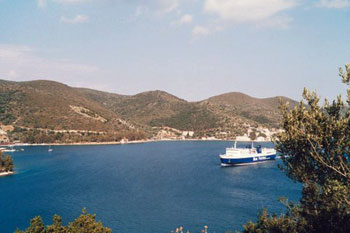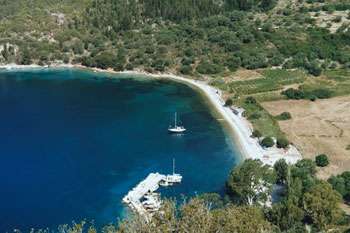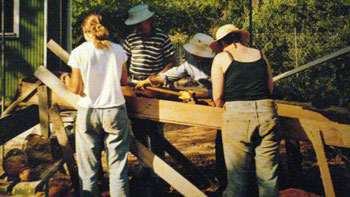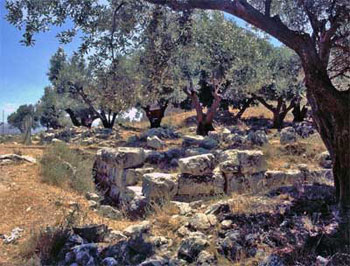
Ithaka, Greece
by W. Ruth Kozak
We approached the coast of this island and brought our ship into the shelter of the haven without making a sound. Some god must have guided us in…”
– Homer, The Odyssey
The ferry rounds Ithaka’s rocky headland into a secret cove. Pretty houses cluster on the slopes of the low hills that surround a horseshoe-shaped bay. The town of Vathi is hidden. You don’t know it is there until you round the arm of the harbor.
Ithaka is an island that ‘happens’ to you. Its curious atmosphere eludes those who would try to pin it down with facts, archaeological and otherwise. Along the island’s rugged coastline are pebbled beaches of moonlike opalescence with water clear as platinum. The ocean, mirror-still one moment can turn to a raging tempest. Ithaka’s hillsides are scented with wild sage and oregano, dotted with vibrant wild-flowers and silvery olive groves. And surrounding the tranquil orchards and vineyards are the high menacing mountains. Homer described it as “an island of goat pastures rising rocklike from the sea.” Although there are no remains to confirm that the plateau of Marathia was the site of Eumaeus’ pig sties, or that the port town of Vathi corresponds to ancient Phorcys where the Phaecians navigated Odysseus, to most of the island’s inhabitants, Homer’s legend is enough to sustain the imagination.
 Life on Ithaka is quiet. There is no nightlife and very few buses run between the villages. Consequently, taxi drivers do a brisk business. Of the population of 2500, most are elderly and retired people. Most young people leave, preferring life in mainland cities for school and work. Those who do remain, mix agriculture with tourism, but the season is only for two months. The Ithakans want more tourism, but they hope to attract mainly a mature public who can appreciate the island’s unique history.
Life on Ithaka is quiet. There is no nightlife and very few buses run between the villages. Consequently, taxi drivers do a brisk business. Of the population of 2500, most are elderly and retired people. Most young people leave, preferring life in mainland cities for school and work. Those who do remain, mix agriculture with tourism, but the season is only for two months. The Ithakans want more tourism, but they hope to attract mainly a mature public who can appreciate the island’s unique history.
Ithakans are known as great navigators and explorers. “The Odyssey” written by the blind poet Homer in the late 7th century BC, depicts the political, cultural and social life of the island during that time. According to tradition, Homer had lived there when he was very young, so he was later able to describe it with such great detail.
 Teams of archaeologists have been digging around the island, looking for evidence of Homer’s Ithaka and Odysseus’ Bronze Age city. I visit the Cave of the Nymphs where a team of American archaeologists and students are busy sifting and sorting through rubble brought up from a ten meter pit. This cave is believed to be the one where Odysseus hid the gifts given to him by the Phaecians when he returned home after his long, arduous voyage. There were originally two caves in two levels, but they have been collapsed by an earthquake. The cave has two entrances, so it fits the description in The Odyssey. Homer says it was a cave dedicated to the Nymphs. The cave has been used as a religious site, so in this way it fits with the Odyssey. These excavations may help identify the location of Homer’s Ithaka.
Teams of archaeologists have been digging around the island, looking for evidence of Homer’s Ithaka and Odysseus’ Bronze Age city. I visit the Cave of the Nymphs where a team of American archaeologists and students are busy sifting and sorting through rubble brought up from a ten meter pit. This cave is believed to be the one where Odysseus hid the gifts given to him by the Phaecians when he returned home after his long, arduous voyage. There were originally two caves in two levels, but they have been collapsed by an earthquake. The cave has two entrances, so it fits the description in The Odyssey. Homer says it was a cave dedicated to the Nymphs. The cave has been used as a religious site, so in this way it fits with the Odyssey. These excavations may help identify the location of Homer’s Ithaka.
The site, four kilometers from Vathi, is closed to the public, but I am allowed entry into the dank, cavernous mouth, to look down into the deep pit where the treasures were hidden. I’m not allowed to take photos, and specific questions such as “Have you found anything yet?” go unanswered.
 Is Ithaka the Homeric Ithaka? German archaeologists have claimed that the island of Lefkada is really the island Homer described. Why would Odysseus have his kingdom a small island such as Ithaka?
Is Ithaka the Homeric Ithaka? German archaeologists have claimed that the island of Lefkada is really the island Homer described. Why would Odysseus have his kingdom a small island such as Ithaka?
On my way to the town of Stavros, I am driven past the rock-strewn remains of what is believed to be the Bronze Age city. According to Homer’s description, Odysseus’ palace was located at a spot overlooking three seas, and surrounded by three mountains. This location, on the Pilikata Hill, fits the description.
At the town of Stavros, a market town, I am introduced to the curator of the museum, who gives me a personal lecture about all the artifacts. She shows me various objects with roosters, symbolic of Odysseus, and bits of boar’s tusks fashioned into helmets. From the cave of Loizos which collapsed in the 1953 earthquake, there are bronze tripods of the type Odysseus was supposed to have hidden and a fragment of a mask marked “Blessings to Odysseus.” There is also a statuette depicting Odysseus tied to a ship’s mast so that he can resist the siren’s seductive song.
Back in Vathi, I walk along the port to my pension. Cafes animate the harbour. The summer evening is scented with the blue smoke of grilling kebabs and fresh-caught fish. In the harbour are yachts from all over the Mediterranean. I am reluctant to leave this extraordinary island.
The next day, I travel by taxi to the northern port of Frikes and board a ferry bound for Lefkada. As the ferry sets sail across the straits, a pod of dolphins frolic alongside. The white limestone cliffs of Ithaka’s shoreline are striped by eerie silvery pink and blue lights. A light breeze stirs the water. I think of Odysseus’ wife, Penelope, and how she waited all those years for him to return I will not soon forget this journey. Ithaka is a place that will draw me back again, too.
If You Go:
♦ Ferries run daily from the port of Patras, or neighboring islands Kefalonia and Lefkada.
♦ Buses run daily from Athens Kiffisiou Street depot, connecting with the ferry at Patras.
♦ Accommodations are available in private homes and hotels on Ithaka. No camping is allowed.
About the author:
Ruth is a historical-fiction writer who combines her research trips with travel writing. On this visit to Ithaka she was lucky to be escorted to the Odysseus site by the mayor of Ithaka, and introduced to the archaeologist, Sarantis Symeonoglou who was in charge of the digs at the Cave of the Nymphs for the Odysseus Project which began in 1988 under the auspices of Washington University. See more of her writing at: www.ruthkozak.com
All photographs are by W. Ruth Kozak.


